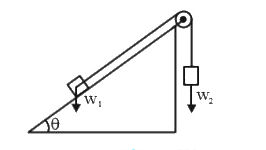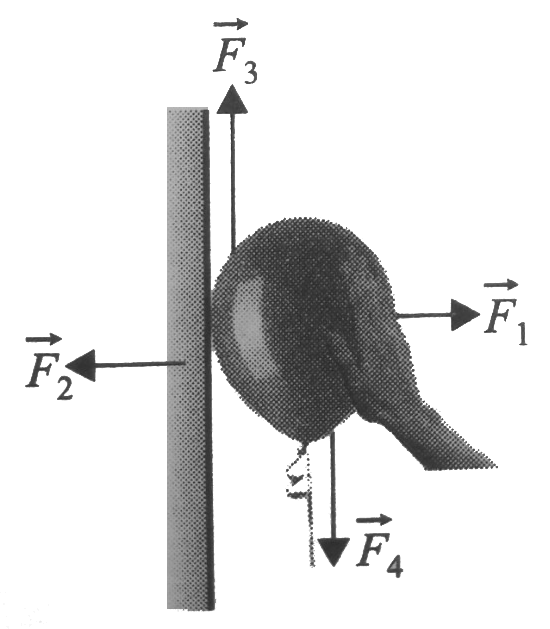Statement-1: Weight of a empty balloon measured in air is w1. If air at atmospheric pressure is filled inside balloon and again weight of balloon is measured. Weight of balloon is w2 is second case. Then W2 is equal to w1
Statement-2: Upthrust is equal to weight of the fluid displaced by the body.
Statement-1, is true, Statement-2 is true, Statement-2 is correct explanation for statement-1
Statement-1 is true, statement-2 is true, statement-2 is NOT a correct explantion for statement-1
statement-1 is true, statement-2 is false
statement-1 is false statement-2 is true
The correct Answer is:A
To analyze the given statements, let's break down the problem step by step.
Step 1: Understanding Statement 1
- Statement 1: The weight of an empty balloon measured in air is w1. When air at atmospheric pressure is filled inside the balloon, the weight of the balloon is measured again as w2. The statement claims that w2 is equal to w1.
Step 2: Analyzing the Weight of the Balloon
- When the balloon is empty, its weight is simply w1.
- When the balloon is filled with air, the weight of the air inside the balloon contributes to the total weight. However, this air displaces an equal volume of air from the atmosphere.
Step 3: Understanding Buoyant Force
- According to Archimedes' principle, the buoyant force (upthrust) acting on the balloon is equal to the weight of the fluid (in this case, air) displaced by the balloon.
- If the weight of the air inside the balloon is W0, then the buoyant force acting on the balloon is also W0.
Step 4: Balancing Forces
- When the balloon is filled with air, the weight of the balloon plus the weight of the air inside it is balanced by the buoyant force.
- Thus, we can write the equation:
w2=w1+W0−W0
Simplifying this gives:
w2=w1
- Therefore, the first statement is true.
Step 5: Understanding Statement 2
- Statement 2: Upthrust is equal to the weight of the fluid displaced by the body.
- This is a direct application of Archimedes' principle and is universally accepted in fluid mechanics.
Conclusion
- Both statements are independently true. Statement 1 is true because the weight of the balloon remains the same when filled with air due to the balance of forces. Statement 2 is true as it correctly describes the principle of buoyancy.
Final Answer
Both Statement 1 and Statement 2 are true, and Statement 2 provides the correct explanation for Statement 1.
---
- Statement 1: The weight of an empty balloon measured in air is w1. When air at atmospheric pressure is filled inside the balloon, the weight of the balloon is measured again as w2. The statement claims that w2 is equal to w1.
- When the balloon is empty, its weight is simply w1.
- When the balloon is filled with air, the weight of the air inside the balloon contributes to the total weight. However, this air displaces an equal volume of air from the atmosphere.
- According to Archimedes' principle, the buoyant force (upthrust) acting on the balloon is equal to the weight of the fluid (in this case, air) displaced by the balloon.
- If the weight of the air inside the balloon is W0, then the buoyant force acting on the balloon is also W0.
- When the balloon is filled with air, the weight of the balloon plus the weight of the air inside it is balanced by the buoyant force.
- Thus, we can write the equation:
w2=w1+W0−W0
Simplifying this gives:
w2=w1
- Therefore, the first statement is true.
- Statement 2: Upthrust is equal to the weight of the fluid displaced by the body.
- This is a direct application of Archimedes' principle and is universally accepted in fluid mechanics.
- Both statements are independently true. Statement 1 is true because the weight of the balloon remains the same when filled with air due to the balance of forces. Statement 2 is true as it correctly describes the principle of buoyancy.
Both Statement 1 and Statement 2 are true, and Statement 2 provides the correct explanation for Statement 1.
Topper's Solved these Questions
- ELASTICITY, SURFACE TENSION AND FLUID MECHANICSBOOK - ALLENCHAPTER - ELASTICITY, SURFACE TENSION AND FLUID MECHANICSEXERCISE - Exercise 3 (Comprehension based questions)
24 Videos
- ELASTICITY, SURFACE TENSION AND FLUID MECHANICSBOOK - ALLENCHAPTER - ELASTICITY, SURFACE TENSION AND FLUID MECHANICSEXERCISE - Exercise 4 A (Elasticity)
7 Videos
- ELASTICITY, SURFACE TENSION AND FLUID MECHANICSBOOK - ALLENCHAPTER - ELASTICITY, SURFACE TENSION AND FLUID MECHANICSEXERCISE - Exercise 2 (One or more than one correct answer)
53 Videos
- CENTRE OF MASSBOOK - ALLENCHAPTER - CENTRE OF MASSEXERCISE - EXERCISE-V B
19 Videos
- ERROR AND MEASUREMENTBOOK - ALLENCHAPTER - ERROR AND MEASUREMENTEXERCISE - Part-2(Exercise-2)(B)
22 Videos
Similar Questions
An empty balloon weighs W1. If air equal in weight to W is pumped into the balloon, the weight of the balloon becomes W2. Suppose that the density of air inside and outside the balloon is the same. Then
View SolutionStatement-1: The size of a hydrogen increases as it rises in air.
Statement-2: The material of the balloon can be easily stretched.
View SolutionIn the accompanying diagram W1 is 5kg weight and W2 is 3 kg weight. If the component of W1 parallel to the incline is equal to W2, then the angle θ is nearly :

View Solution
In the figure shown, a balloon is pressed against a wall. It is in equilibrium and maximum compressed state.
→F= force of balloon on hand of man, →F2= force of balloon on wall,→F3= friction,→F4= weight of balloon. Which of the following statements are correct:
View Solution_E01_093_Q01.png)
A ballong filled with air is weighted so that it barely floats in water as shown in figure. When it is pushed down so that it gets submerged a short distance in water then the balloon
View SolutionThe apparent weight of a man in a lift is W1 when lift moves upwards with some acceleration and is W2 when it is accerating down with same acceleration. Find the true weight of the man and acceleration of lift .
View SolutionStatement-1 : A balloon filled with CO2 gas acts as a coverging lens for a sound wave
Statement-2 : Sound waves travel faster in air than in CO2
View SolutionThe apparent weight of a person inside a lift is w1 when lift moves up with a certain accelration and is w2 when lift moves down with same acceleration. The weight of the person when lift moves up with constant speed is :
View SolutionA body weighs W1 gf in air and when immersed in a liquid, it weighs W2 gf, while it weighs W3 gf on immersing it in water. Find (i) Volume of the body (ii) upthrust due to liquid (iii) relative density of the solid and (iv) relative density of the liqudi.
View SolutionIn a given figure system is in equlibrium, If W1= 300 N. Then W2 is approximately equal to

View Solution
